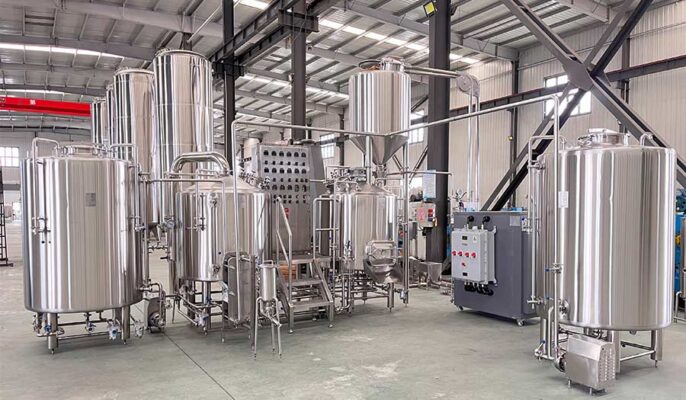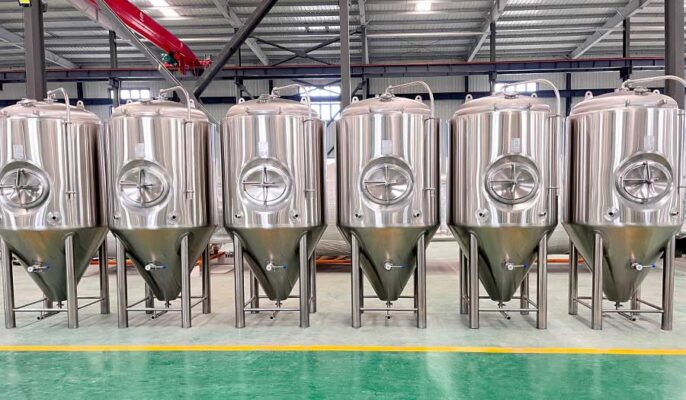Small batch brewing equipment dominates the brewing industry. Unlike commercial brewing, small batch beer offers a hands-on approach to production. Each step of the process can be customized to suit individual tastes. In this guide, we’ll explore together how to choose small-batch brewing equipment and the brewing process, among other things.
What is small batch brewing?
Small-batch brewing is when a smaller amount of beer is brewed compared to a commercial brewery. It typically brews about 1 to 5 gallons of beer. This smaller size allows for better control of the brewing process and allows the brewer to experiment with unique ingredients and flavors.
Small-batch brewing is not only a way to create personalized and unique beers, but it also provides a more practical approach to the brewing process. With smaller equipment and volume, brewers can observe and adjust each step, allowing for a deeper understanding of brewing techniques and their impact on the final product.
Small Batch Brewing Processes
- Mash: this process activates enzymes in the malt that convert starch into fermentable sugars, producing a sweet liquid called wort.
- Boiling: this is the stage where you must boil the wort and add hops at various intervals. This process also sanitizes the wort, stopping enzyme activity and precipitating proteins that can cloud the beer.
- Fermentación: This stage converts the sugary wort into beer, producing alcohol and carbon dioxide as well as flavor compounds such as esters and phenols. Depending on the type of beer, fermentation can take anywhere from a few days to a few weeks.
- Secondary Fermentation: this is the stage where flavors mature. To achieve natural carbonation, you can add trigger sugars before bottling or force carbonation in the keg.
Each step in the brewing process provides the brewer with the opportunity to tweak and experiment, which affects the final beer’s taste, aroma, body, and clarity.

Small Batch Brewing Equipment
Hervidor de cerveza
One of the main pieces of equipment needed to brew small-batch beer is a brew kettle. These containers are specifically designed to boil the ingredients and impart flavor to the beer. Brew kettles come in a variety of sizes and materials, such as stainless steel and aluminum. They usually come with handles, faucets, and lids to facilitate the brewing process.
Fermentador
After boiling the wort in the brew kettle, it’s time to transfer it to the fermentation vessel and let the yeast work its magic. Large glass carboys and plastic buckets are the most common types of fermentation vessels used in small-batch brewing. Large glass carboys are usually made of glass or plastic and allow you to visually monitor the fermentation process. Plastic buckets are affordable and easy to clean, making them a popular choice for home brewers.
Equipos de embotellado
Once the beer has fermented and undergone any secondary processing, it is ready to be bottled and consumed. Bottling equipment includes bottling machines, cappers, and bottle brushes. Bottling machines make the bottling process more efficient by minimizing spills and ensuring consistent fill levels. Cappers securely seal bottles, while bottle brushes help clean and sanitize bottles before filling.
How to Choose Small Batch Brewing Equipment?
Volumen de producción
When choosing brewing equipment, an essential consideration is determining production volume. State clearly how much beer you intend to brew in a specific time frame. This decision should consider market demand, distribution channels, and realistic growth projections. Knowing your target production volume will guide you in selecting equipment that can effectively achieve your production goals.
|
Equipos de elaboración de cerveza |
Capacidad |
Tamaño del lote |
|
1-Gallon System |
1 gallon (3.8 liters) |
Approximately 10 to 12 bottles (12 oz each) |
|
5-Gallon System |
5 gallons (18.9 liters) |
Approximately 48 to 52 bottles (12 oz each) |
|
10-Gallon System |
10 gallons (37.8 liters) |
Approximately 96 to 100 bottles (12 oz each) |
Selección de materiales
- Stainless Steel Brewing Equipment: Stainless steel brewing equipment is a popular choice for home brewers. First, stainless steel is very durable and rust-resistant, making it a long-term choice for your brewing needs. The material is also less porous than plastic, reducing the risk of bacteria growth or giving your beer an off-flavor.
- Plastic Brewing Equipment: Plastic brewing equipment is typically made from food-grade high-density polyethylene (HDPE), which offers a range of advantages. One of the main advantages is that it is affordable, making it an affordable option for those just starting to brew beer. However, it is important to note that plastic is more susceptible to scratches and degradation over time, which can breed bacteria and may affect the taste and quality of your beer.
|
Material |
Pros |
Contras |
|
Acero inoxidable |
Durable and resistant to rust |
Higher price |
|
Plástico |
Affordable |
More susceptible to scratches and degradation |
Brewing Process and Batch Size
Evaluate your brewing process and determine the typical batch size you plan to produce. Whether you focus on a small batch process or larger batches, your equipment selection should align with your brewing style, recipe complexity, and the number of fermenters and storage vessels required. Your brewing equipment should seamlessly adapt to your desired batch size.
Budget and Financial Considerations
Understand your budget constraints and financial goals when choosing brewing equipment. While cost is an important factor, balance your budget with the long-term value and performance of your equipment. Consider factors such as equipment life, warranty, maintenance costs, and potential return on investment to make an informed decision.
Requisitos de servicios públicos
Evaluate the utility requirements for your brewing equipment, including specifications for electricity, water, and gas supply. Make sure your facility can meet these requirements to support the selected equipment. Consulting with utility providers and equipment manufacturers can help you determine the exact specifications needed for seamless integration.
Brand Reputation and Reviews
When investing in small-batch brewing equipment, knowing the trusted brands can make a big difference in your brewing experience. Researching brewing equipment brands and reading customer reviews are important steps in assessing the quality and reliability of the products you are considering. By taking the time to gather information and insights from other brewers, you can make an informed decision and find equipment that meets your needs.

Preguntas frecuentes
How do I fix stagnant fermentation?
Yeast stops moving prematurely, causing the beer to under-ferment, resulting in stagnant fermentation. To solve this problem, make sure the pitching rate is adequate and if necessary, gently move the yeast or consider introducing a fresh yeast culture.
What types of small-batch brewing equipment are available?
There are several types of small-batch brewing equipment available, including brew pots, fermenters, bottling equipment, and more. Each type has its advantages and considerations. Understanding the different options will help you make an informed decision and choose equipment that matches your brewing style.
How should I establish a budget for my brewing equipment?
Setting a budget for brewing equipment depends on your situation and brewing goals. Considerations include your dedication to the hobby, the quality of equipment you require, and your long-term investment plans. It’s important to strike a balance between affordability and quality to ensure you get what you pay for.
What batches can small-batch brewing equipment accommodate?
Small-batch brewing equipment comes in a variety of sizes to accommodate different batch sizes. Before purchasing, assess your brewing requirements and determine the volume of beer you want to produce. This will help you choose equipment that can handle the desired batch size without compromising brewing quality.
What material should I consider using for my brewing equipment?
The material of your brewing equipment affects the quality and durability of your beer. Common materials include stainless steel and plastic. Stainless steel is known for its strength, rust resistance, and ease of cleaning, while plastic is lightweight and often more affordable. When choosing a material, consider your brewing preferences and long-term goals.




